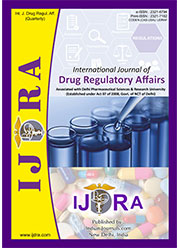A Comparative study of Regulations of Cell and Gene therapy in US, EU and India
Abstract
Cell and Gene therapy products were a field that is growing fast inventive therapies. The United States (US) and the European Union (EU) are encouraging their evolution and India is in its nascent stage. For three regions, CGTs fall beneath the biological merchandise regulatory framework of it requires the legal foundation for their evolution. In the EU, there is a defined trend between cell- and gene-based products concerning their classification as advanced therapies or coverage by the legal frameworks, while in the United States there is a wide classification as to classified as organic products. In EU, USA and India, to allocate a cell or an gene product’s as innovative therapy, care has to be taken for therapy of cells involves manoeuvres that amend their characters which are organic, as the term tactic in the USA is difference between systemic and non- systemic cells and gene therapy products. A descriptive analysis was carried out. Till now in USA 20 CGTPs are approved, out of 20 GTMP consists of 7 and CTMP consists of 13 products. Many products are under clinical trials, I searched clinical trials website to know the status of clinical trials in USA. I found 355 clinical trials under ATMPs, out of 355 GTMP consist of 225, SCTMP consists of 105, and CATMP consists of 25. In India the procedures are of two types which are to speed up the drug approval process for the betterment of everyone. They are 1) Conditional Approval, 2). Fast Track Approval. There are only 4 products were approved namely Apceden, Stempeucel, Ossgrow and Cartigrow. The problems related to clinical has been degenerate as the unproven stem cell clinics numbers in the USA reportedly were increased to approximately 715 by 2017. Therefore, the unproven industry of sanatorium is a moving intention essential in method examine and regulatory lapse.
Downloads
References
https://bioscience.lonza.com/lonza_bs/IN/en/cell-and-gene-therapy
2. ThermoGenesis. The History of Cell and Gene Therapy [Internet]. ThermoGenesis; 2021 Apr 13 [cited 2022 Nov 11]. Available from:
https://thermogenesis.com/the-history-of-cell-and-gene-therapy/
3. Mitha. Labiotech.eu.The Return of Gene Therapy [Internet]. Labiotech.eu; 2020 Nov 04 [cited 2022 Nov 10]. Available from:
https://www.labiotech.eu/in-depth/gene-therapy-history/
4. Iglesias-Lopez C, Agustí A, Obach M and Vallano. A Regulatory Framework for Advanced Therapy Medicinal Products in Europe and United States. Front. Pharmacol. 2019;10:921.
doi: 10.3389/fphar.2019.00921
5. Framework for the Regulation of Regenerative Medicine Products [Internet]. U.S. Food and Drug Administration; 2017 [cited 2020 Nov 07]. Available from:
https://www.fda.gov/vaccines-blood-biologics/cellular-gene-therapy-products/frameworkregulation-regenerative-medicine-product
6. The Indian Council of Medical Research (ICMR), New Delhi. Features of Gene Therapy, 2017 [Internet]. ICMR;2017 [cited 2022 Nov 09]. Available from: https://main.icmr.nic.in/sites/default/files/guidelines/Guidelines_for_stem_cell_research_201 7.pdf
7. The Indian Council of Medical Research (ICMR), New Delhi. Features of Gene Therapy, 2019 [Internet]. ICMR;2019 [cited 2022 Nov 09]. Available from: https://main.icmr.nic.in/sites/default/files/photogallerydocs/salient_features_gene_therapy.pdf
8. Rana P and Chawla S. Orphan drugs: trends and issues in drug development. Journal of Basic and Clinical Physiology and Pharmacology. 2018; 29(5):437-446.
https://doi.org/10.1515/jbcpp-2017-0206

This work is licensed under a Creative Commons Attribution-NonCommercial 4.0 International License.
The International Journal of Drug Regulatory affairs require a formal written transfer of copyright from the author(s) for each article published. We therefore ask you to complete and return this form, retaining a copy for your records. Your cooperation is essential and appreciated. Any delay will result in a delay in publication.
I/we have read and agree with the terms and conditions stated Page 2 of this agreement and I/we hereby confirm the transfer of all copyrights in and relating to the above-named manuscript, in all forms and media, now or hereafter known, to the International Journal of Drug Regulatory affairs, effective from the date stated below. I/we acknowledge that the IJDRA is relying on this agreement in publishing the above-named manuscript. However, this agreement will be null and void if the manuscript is not published in the IJDRA.
Download link for COPYRIGHT FORM







